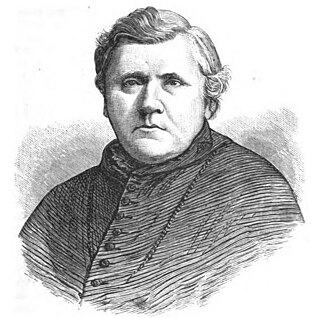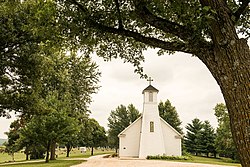
The Archdiocese of Dubuque is a Latin Church ecclesiastical territory or archdiocese of the Catholic Church in the northeastern quarter of the state of Iowa in the United States.

The Diocese of Davenport is a Latin Church ecclesiastical jurisdiction or diocese of the Catholic Church for the southeastern quarter of the U.S. state of Iowa. There are 11,438 square miles (29,620 km2) within the diocese. The diocese's eastern border is at the Mississippi River; the northern border comprises the counties of Jasper, Poweshiek, Iowa, Johnson, Cedar, and Clinton; the western border is made up of the counties of Jasper, Marion, Monroe, and Appanoose; and the southern border is the Iowa–Missouri border.

Sacred Heart Cathedral, located in Davenport, Iowa, United States, is a Catholic cathedral and a parish church in the Diocese of Davenport. The cathedral is located on a bluff overlooking the Mississippi River to the east of Downtown Davenport. It is listed on the National Register of Historic Places as part of the Sacred Heart Roman Catholic Cathedral Complex. This designation includes the church building, rectory, and the former convent, which was torn down in 2012. The cathedral is adjacent to the Cork Hill Historic District, also on the National Register. Its location on Cork Hill, a section of the city settled by Irish immigrants, gives the cathedral its nickname Cork Hill Cathedral.

The Diocese of Des Moines is a Latin Church ecclesiastical territory or diocese of the Catholic Church in the southwestern quarter of the U.S. state of Iowa. It is a suffragan see in the ecclesiastical province of the metropolitan Archdiocese of Dubuque. The see city for the diocese is Des Moines. The cathedral parish for the diocese is St. Ambrose. Currently Bishop William Michael Joensen is the bishop of the diocese.
William Edwin Franklin is an American prelate of the Roman Catholic Church, He served as an auxiliary bishop of Archdiocese of Dubuque in Iowa from 1987 to 1993, and as bishop of the Diocese of Davenport, also in Iowa, from 1993 to 2006.

John McMullen was an Irish-born prelate of the bishop of the Roman Catholic Church. He served as the first bishop of the Diocese of Davenport in Iowa from 1881 to until his death in1883.

St. Ambrose Cathedral is a historic building located in downtown Des Moines, Iowa, United States. It serves as a parish church and as the seat of the Diocese of Des Moines in the Catholic Church. The cathedral, along with the adjoining rectory, was listed on the National Register of Historic Places in 1979.

The Basilica of St. John is a Minor Basilica of the Catholic Church in the Drake neighborhood of Des Moines, Iowa, United States. It is also a parish church in the Diocese of Des Moines. The church building is listed on the National Register of Historic Places.

James Joseph Davis was an Irish-born prelate of the Roman Catholic Church. He served as the third bishop of the Diocese of Davenport in Iowa from 1906 to until his death in 1926.

Maurice John Dingman was an American bishop of the Catholic Church. He served as Bishop of Des Moines from 1968 to 1986.

St. Mary of the Visitation Catholic Church is a parish of the Diocese of Davenport. The church building is located on the corner of 4th and Court Streets in downtown Ottumwa, Iowa, United States. It is part of the Central Park area, which is the civic center of the community. It includes: the Wapello County Courthouse, the Ottumwa Public Library, and the Ottumwa City Hall. The church is eligible for the National Register of Historic Places, but it has not been listed.

Jean-Antoine-Marie Pelamourgues (1811–1875) was a French missionary who was one of the first Roman Catholic priests to serve in the Diocese of Dubuque in the state of Iowa. He served as the first pastor of St. Anthony's Church in Davenport, Iowa from 1839 to 1868.
St. Patrick's Catholic Church is a parish of the Diocese of Davenport. The church is located in rural Monroe County, Iowa, United States, on U.S. Highway 34, west of Albia, Iowa. It is located in an unincorporated area known as Georgetown and is listed on the National Register of Historic Places.

St. Michael's Catholic Church is a former parish of the Diocese of Davenport. The church is located in the unincorporated village of Holbrook, east of Parnell, Iowa, United States. It is listed on the National Register of Historic Places as St. Michael's Church, Cemetery, Rectory, and Ancient Order of Hibernians Hall in 1983.
John George Alleman was a missionary Catholic priest who served in the states of Ohio, Iowa and Illinois. He served as a priest in the Dominican Order from 1834 to 1840, after which time he was expelled from the order. He then served as a secular priest in the Diocese of Dubuque from 1840 to 1851, and in the Diocese of Chicago from 1851 to 1863. During his hospitalization in St. Louis, Missouri, (1863–1865) he was accepted back into the Dominican Order.

St. Peter's Catholic Church is a parish of the Diocese of Des Moines. The church is located in Council Bluffs, Iowa, United States. It was listed on the National Register of Historic Places in 1992 as St. Peter's Church and Rectory.

St. Boniface Catholic Church is a parish of the Diocese of Des Moines. The church is located in Westphalia, Iowa, United States, and the parish plant is listed on the National Register of Historic Places as Saint Boniface Catholic Church District. At the time of its nomination the district consisted of 16 resources, including six contributing buildings, one contributing structure, two contributing sites, one contributing object, six noncontributing buildings, and one noncontributing object.

St. Paul's Catholic Church is an historic church building located in Burlington, Iowa, United States. Together with the Church of St. John the Baptist in Burlington and St Mary's Church in West Burlington it forms Divine Mercy parish, which is a part of the Diocese of Davenport. The parish maintains the former parish church buildings as worship sites. St. Paul's Church and the rectory are contributing properties in the Heritage Hill Historic District listed on the National Register of Historic Places. St. Paul's School was also a contributing property in the historic district, but it has subsequently been torn down.

St. Augustin Catholic Church is a Catholic parish in the Diocese of Des Moines located on the west side of Des Moines, Iowa, United States. It was included as a contributing property in the Greenwood Park Plats Historic District and listed on the National Register of Historic Places in 2013.

St. Anthony's Catholic Church is a Catholic parish church in the Diocese of Des Moines located on the south side of Des Moines, Iowa, United States. It was listed on the National Register of Historic Places in 2021.




















